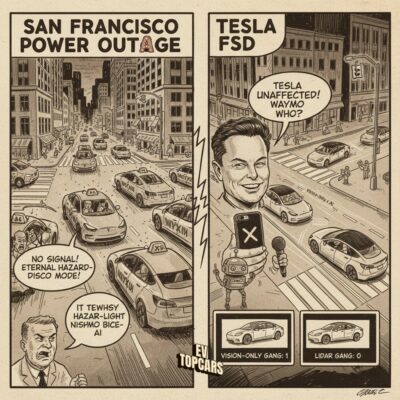Do you own an electric vehicle (EV) or plan to buy one? If so, you’ve likely heard about mobile EV charging. This innovative technology is changing the way we charge our electric cars, making it more convenient and accessible. Yes, gone are the days of searching for a charging station and waiting for hours to get your car fully charged. With mobile EV charging, you can now charge your electric vehicle anytime and anywhere.
But what exactly is mobile EV charging, and how does it work? Here, we’ll discuss the different types of mobile EV charging, factors to consider when using it, and its advantages and disadvantages. These will help you understand if mobile EV charging is the right option for your electric vehicle.
Related Article: Why Mobile Charging is Essential for Electric Vehicle Owners?
What is Mobile EV Charging?
Mobile EV charging, also known as on-the-go or portable charging. This technology allows you to charge your electric vehicle using a portable charging unit, instead of relying on a fixed charging station. Yes, you heard that right – you can now charge your electric car on the go, just like charging your smartphone.
It’s a game-changer for electric vehicle owners, as it eliminates the need to find and access a charging station. You can charge your car at home, work, or even on a road trip without worrying about the availability of charging stations. Plus, it’s compatible with all types of electric vehicles, whether you own a Tesla or a Nissan Leaf. This makes it a convenient and accessible option for all-electric vehicle owners. Let’s take a look at the different types of mobile EV charging.
Types of Mobile EV Charging
There are two types of mobile EV chargers: Level 1 and Level 2. Each has its own advantages and disadvantages, so it’s essential to understand their differences before deciding which one is right for you.
Level 1 Mobile EV Charging
Level 1 charging uses a standard outlet (120 volts) that you can find in any home or office. It’s the slowest form of charging, with an average rate of 2-5 miles per hour. This means it will take approximately 20-30 hours to fully charge an electric vehicle with a 60-kWh battery using Level 1 charging.
Although it may seem slow, Level 1 charging is still a convenient option for daily use. You can easily plug in your car overnight and wake up to a fully charged vehicle. Plus, it’s the most affordable option, as you don’t need to invest in any additional equipment.
You need to consider the electrical capacity of your home before opting for Level 1 charging. If you have an older home with outdated wiring, it may not be able to handle the load of Level 1 charging. In this case, you may need to upgrade your electrical system before using this type of mobile EV charger. It’s always best to consult with a professional electrician before making any changes to your home’s electrical setup.
However, Level 1 charging may not be suitable for longer trips or when you need a quick charge. Yes, this is where Level 2 charging comes in. But it doesn’t mean it doesn’t have its own advantages. Let’s take a look at the pros and cons of Level 1 charging.
Advantages of Level 1 Mobile EV Charging
- An affordable option, as it doesn’t require any additional equipment like a charging station.
- Can be used with any standard outlet, making it accessible and convenient.
- Suitable for daily charging needs, especially if you have a shorter commute.
- A safe option, as it doesn’t put a strain on your home’s electrical system.
- Can be easily installed and doesn’t require any professional assistance.
- Provides more flexibility, as you can charge your vehicle at any location with an outlet.
- Can be used for emergency charging situations, such as during power outages or on road trips.
These are just some of the advantages of Level 1 mobile EV charging. However, it also has its disadvantages, which we will discuss next.
Learn More: How to Choose the Best E-Scooter for Your Lifestyle
Disadvantages of Level 1 Mobile EV Charging
- Slow charging rate, which may not be suitable for longer trips or when you need a quick charge.
- May not be compatible with older homes or outdated electrical systems.
- Requires a longer charging time, which may not be convenient for those with a busy schedule.
- Can only add approximately 2-5 miles of range per hour, which may not be enough for some electric vehicles.
- May not work well in extreme weather conditions, such as freezing temperatures or high humidity.
- Increases your electricity bill, as it takes longer to charge the vehicle.
These disadvantages may make Level 1 mobile EV charging less attractive to some electric vehicle owners. However, it’s still a viable option for daily use and can be a great backup option in case of emergencies. Now, let’s take a look at Level 2 mobile EV charging and its advantages and disadvantages.
Level 2 Mobile EV Charging
Level 2 charging uses a higher-powered outlet (240 volts) that you can find in commercial spaces or install at home. It’s faster than Level 1 charging, with an average rate of 10-20 miles per hour. This means it will take approximately 4-8 hours to fully charge an electric vehicle with a 60-kWh battery using Level 2 charging.
Level 2 mobile EV chargers are more expensive than Level 1, as they require additional equipment such as a charging station. However, they provide faster charging times and can be more convenient for longer trips or when you need a quick charge.
You can find Level 2 mobile EV chargers at public charging stations, workplaces, and even some shopping centers. Some electric vehicle manufacturers also offer Level 2 chargers as an optional accessory when purchasing a new vehicle. (like Tesla’s Wall Connector).)
There are two types of Level 2 chargers: plug-in and hardwired. Plug-in chargers are portable and can be used at different locations, while hardwired chargers are permanently installed in a specific location.
Here are some advantages and disadvantages of Level 2 mobile EV charging.
Advantages of Level 2 Mobile EV Charging
- Faster charging times, which can be more convenient for longer trips or when you need a quick charge.
- Provides approximately 10-20 miles of range per hour, which is significantly faster than Level 1 charging.
- More versatile, as it can be used with both plug-in and hardwired options.
- Can be installed at home or accessed at public locations such as shopping centers or workplaces.
- May have cost-saving incentives, such as lower electricity rates during off-peak hours.
- Can be used with multiple electric vehicles, making it a great option for households with more than one EV.
- Compatible with most modern homes and electrical systems.
Disadvantages of Level 2 Mobile EV Charging
- Requires additional equipment, such as a charging station, which can be expensive.
- May not be accessible in all public locations, limiting its convenience for longer trips.
- Requires professional installation for hardwired chargers.
- May increase electricity bills, especially if used during peak hours or not taking advantage of cost-saving incentives.
- May put a strain on your home’s electrical system if not properly installed or used with too many other high-powered appliances.
- Not suitable for emergency charging situations, as it requires a specific location and equipment.
Despite its disadvantages, Level 2 mobile EV charging is still considered the most popular option among electric vehicle owners due to its faster charging times and versatility. Now that we’ve discussed both Level 1 and Level 2 mobile EV charging options, let’s weigh the pros and cons of each to help you make an informed decision for your electric vehicle charging needs.
Level 1 vs. Level 2 Mobile EV Charging: Which One is Right for You?
Ultimately, the decision between Level 1 and Level 2 mobile EV charging depends on your specific needs and circumstances. Here are some factors to consider when choosing between the two:
- Your daily commute: If you have a shorter commute and only need to charge your vehicle overnight, Level 1 charging may be sufficient for your needs.
- Your home’s electrical system: Make sure to consult with a professional electrician before using any type of mobile EV charger to ensure it is compatible with your home’s electrical setup.
- Your budget: Level 1 charging can be more affordable since it doesn’t require additional equipment or professional installation. However, if you frequently take longer trips or need a quicker charge, Level 2 charging may be worth the initial investment.
- Your electric vehicle’s battery size: If your electric vehicle has a larger battery capacity (60 kWh or higher), Level 1 charging may not provide enough range for your needs. In this case, Level 2 charging would be more suitable.
- Your access to public charging stations: If you have easy access to Level 2 charging at public locations or your workplace, it may be a more convenient option for longer trips.
Must Read: 5 Helpful Maintenance Tips for Your Electric Vehicle
Final Thoughts
In the end, both Level 1 and Level 2 mobile EV charging have their advantages and disadvantages. It’s important to weigh your options and consider your specific needs before making a decision. Ultimately, the goal is to keep your electric vehicle charged and ready for use whenever you need it.
As technology continues to advance, we can expect even faster and more efficient mobile EV charging options in the future. Whether you choose Level 1 or Level 2 mobile EV charging, you’re taking a step towards a more sustainable and environmentally friendly mode of transportation.
Frequently Asked Questions (FAQs)
What is the difference between Level 1 and Level 2 EV charging?
Level 1 charging uses a standard 120-volt outlet and is slower, providing about 2-5 miles of range per hour. Level 2 charging uses a 240-volt outlet, is faster, and delivers approximately 10-20 miles of range per hour.
What is the price for installing a Level 2 EV charger at home?
The cost can vary widely but typically ranges from $500 to $2,000, including equipment and professional installation. Factors like your home’s electrical setup can impact the overall cost.
Can I use a Level 2 charger with any electric vehicle?
Most modern electric vehicles are compatible with Level 2 chargers, but it’s always best to check your vehicle’s specifications or consult with the manufacturer to confirm.
Is it safe to install a Level 2 charger myself?
While some Level 2 chargers are plug-in and can be installed without professional help, it is generally recommended to hire a certified electrician to ensure safety and compatibility with your home’s electrical system.
Do public Level 2 charging stations cost money to use?
Many public charging stations charge for use, either by the hour or per kWh. Some locations offer free charging, but fees typically apply. It’s best to check with the specific provider or use charging apps to find the details.










Why Mobile Charging is Essential for Electric Vehicle Owners?
How to Choose the Best E-Scooter for Your Lifestyle